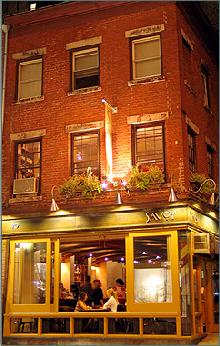Review Preview: Savoy
 Tuesday, June 9, 2009 at 02:56PM
Tuesday, June 9, 2009 at 02:56PM Record to date: 1–2 
Tomorrow, Frank Bruni reviews Savoy, where chef Peter Hoffman has been doing haute barnyard cuisine since long before you could find it on every street corner.
The Skinny: The Times has reviewed Savoy twice. In 1993, Bryan Miller awarded no stars:
Savoy is a baffling restaurant. It is a seductive little place on a shadowy corner of SoHo, with a brick hearth, folkloric knickknacks and a determined husband-wife team in charge. Yet the food is as uneven as the craggy cobblestone streets around it.
The two-and-a-half-year-old Savoy is the creation of Peter Hoffman, the chef, and his wife, Susan Rosenfeld, who runs the front of the house and makes pastries… This neighborly setting is not the kind of place where you want to discuss your divorce settlement unless you don’t mind unsolicited advice from everyone else in the room.
 Bryan Miller, it should be noted, was a much harder grader than any of his successors. Ruth Reichl, on the other hand, was much more generous. Despite significant caveats, she awarded two stars in 1995:
Bryan Miller, it should be noted, was a much harder grader than any of his successors. Ruth Reichl, on the other hand, was much more generous. Despite significant caveats, she awarded two stars in 1995:
Savoy may very well not be for you. There is something resolutely unprofessional about a place that revels in its unevenness, refusing to do the same thing twice. The service can be slow and the chef’s experiments sometimes fail. But if you have an adventurous spirit, you will discover a sense of fun that is missing in most modern restaurants. Eating at Savoy you get the feeling that the people who run it like food, like themselves and like what they are doing.
The restaurant was remodeled in 2002, leading to this Diner’s Journal update from William Grimes:
A restaurant as tiny as the Savoy doesn’t seem as if it could subdivide, but it has. After nearly 13 years the restaurant has shed its Garbo-like image of secrecy, transforming the ground floor into a modern-looking cafe with diner overtones. The upstairs bar has been moved downstairs, the entrance to the restaurant has been shifted northward to the corner of Prince and Crosby Streets, and huge windows now make the Savoy’s interior almost shockingly visible to the outside world. The upstairs remains old-fashioned and intimate. The brick fireplace survives intact.
Peter Hoffman, the Savoy’s chef and owner, sticks with the same cooking philosophy that has won the Savoy a loyal following over the years, shopping the greenmarkets for local produce and pushing organic foods whenever possible. The makeover now gives him two formats: an all-day cafe menu and a more formal menu in the upstairs dining room.
We have visited the current version of Savoy twice, in November 2006 and three months ago, rating it at at two stars on both occasions. It is precisely the kind of earnest, family-run restaurant that Frank Bruni loves. The chef has since opened Back Forty, a more casual place, in the East Village. Except for that, he has kept his eye on the ball, and we doubt that Bruni would see any point in demoting it to one star.
The trifecta is an outside possibility, but we strongly believe that three-star restaurants don’t hide in plain sight. If a twenty-year-old place that everyone knows about is one of the top 20-odd restaurants in the city, we doubt that Bruni would be the first to notice.
Re-reviews need a raison d’être. Obviously a rating change is reason enough in itself—and, to be honest, most of Bruni’s re-reviews do bring a change of rating. But in this case, given that Savoy hasn’t been reviewed in 14 years, the opportunity to give a shout-out might be all the reason Bruni needs.
The Prediction: We predict that Frank Bruni will re-affirm two stars for Savoy.
 Peter Hoffman,
Peter Hoffman,  Savoy in
Savoy in  Review Preview
Review Preview 



























